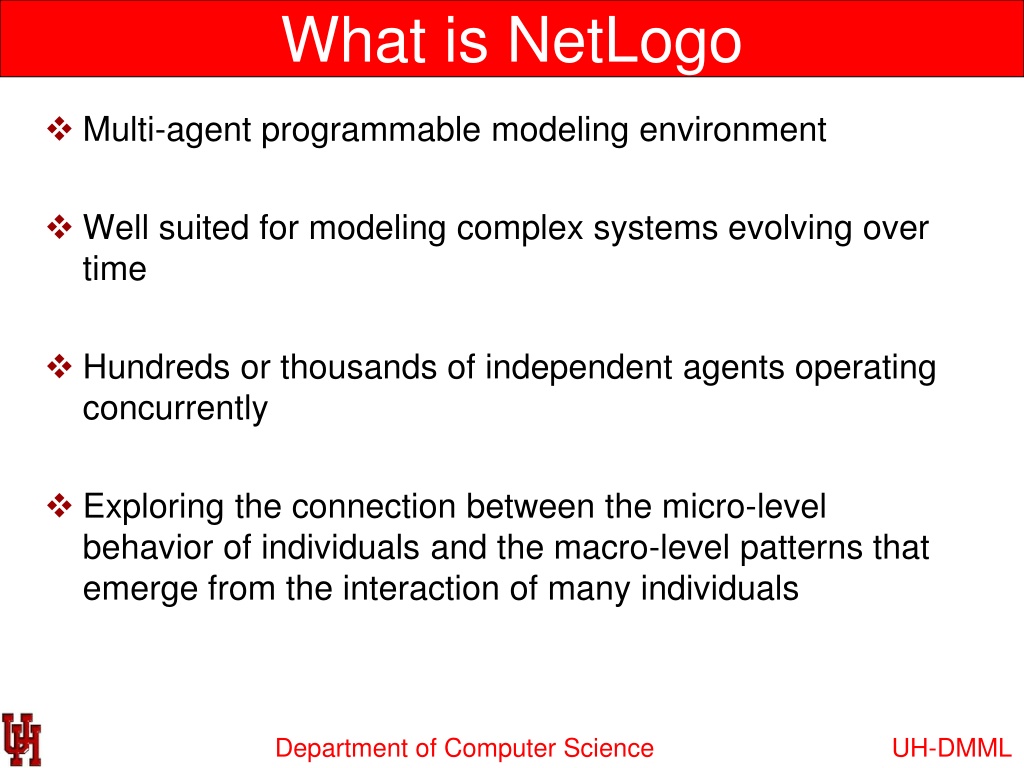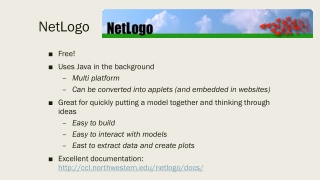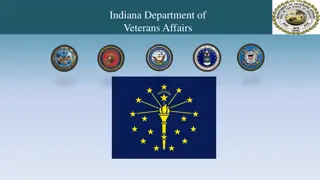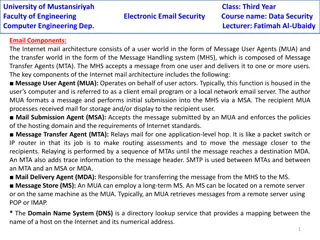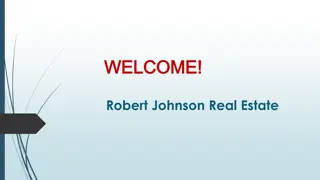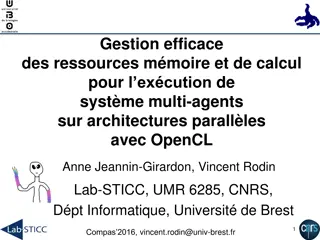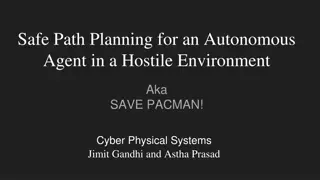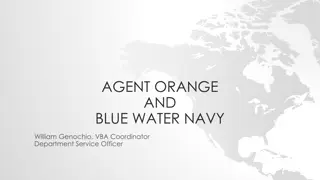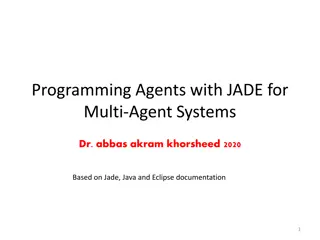Understanding NetLogo: A Multi-Agent Modeling Environment
NetLogo is a versatile multi-agent programmable modeling environment ideal for simulating complex systems with hundreds or thousands of agents. It explores the connection between individual behavior and emergent macro-level patterns, offering an easy-to-use application development environment with a simple scripting language and user-friendly graphical interface. The history of NetLogo stems from LOGO and StarLogo, evolving into a widely used platform today. It features a 2-D world comprising patches, turtles, the observer, and links for creating various models.
Download Presentation

Please find below an Image/Link to download the presentation.
The content on the website is provided AS IS for your information and personal use only. It may not be sold, licensed, or shared on other websites without obtaining consent from the author. Download presentation by click this link. If you encounter any issues during the download, it is possible that the publisher has removed the file from their server.
E N D
Presentation Transcript
What is NetLogo Multi-agent programmable modeling environment Well suited for modeling complex systems evolving over time Hundreds or thousands of independent agents operating concurrently Exploring the connection between the micro-level behavior of individuals and the macro-level patterns that emerge from the interaction of many individuals Department of Computer Science UH-DMML
What is NetLogo Easy-to-use application development environment Opening simulations and playing with them Creating custom models: quickly testing hypotheses about self-organized systems Models library: large collection of pre-written simulations in natural and social sciences that can be used and modified Simple scripting language & User-friendly graphical interface Department of Computer Science UH-DMML
What is NetLogo History LOGO (Papert & Minsky, 1967) Theory of education based on Piaget s constructionism ( hands-on creation and test of concepts) Simple language derived from LISP Turtle graphics and exploration of microworlds StarLogo (Resnick, 1991), MacStarLogo, StarLogoT Agent-based simulation language Exploring the behavior of decentralized systems through concurrent programming of 100s of turtles Department of Computer Science UH-DMML
What is NetLogo History NetLogo (Wilensky, 1999) Further extending StarLogo (continuous turtle coordinates, cross-platform, networking, etc.) Most popular today (growing cooperative library of models) Department of Computer Science UH-DMML
What is NetLogo World of NetLogo NetLogo is a 2-D world made of 4 kinds of agents: 1) patches make up the background or landscape 2) turtles move around on top of the patches 3) observer oversees everything going on in the world 4) links agents that connect two turtles patch-only models Department of Computer Science UH-DMML
What is NetLogo turtle-only models turtle & patch models Department of Computer Science UH-DMML
Graphic Interface Controls Allow to run and control the flow of execution 1) buttons 2) command center Buttons - initialize, start, stop, step through the model 1) once buttons execute one action (one piece of code) 2) forever buttons repeat the same action (the same piece of code) until pressed again Command center ask observer, patches or turtles to execute specific commands on the fly Department of Computer Science UH-DMML
What is NetLogo Settings Allow to modify parameters 1) sliders 2) switches 3) choosers sliders adjust a quantity from min to max by an increment initial-number-sheep = 82 switches set a Boolean variable (true/false) show-energy? = false Department of Computer Science UH-DMML
What is NetLogo Settings choosers select a value from a list file = Beats/seth2.csv Department of Computer Science UH-DMML
What is NetLogo Views output text areas log text info 1) monitors 2) Plots 3) output text areas 4) graphics window monitors display the current value of variables plots display the history of a variable s value Department of Computer Science UH-DMML
What is NetLogo Views output text areas log text info graphics window Department of Computer Science UH-DMML
Programming Concepts Agents-- carry out their own activity, all imultaneously. 1) patches 2) turtles 3) observer 4) links Patches 1) don t move, form a 2-D wrap-around grid 2) have integer coordinates (pxcor, pycor) Turtles 1) move on top of the patches, not necessarily in their center 2) have decimal coordinates (xcor, ycor) and orientation (heading) Department of Computer Science UH-DMML
Programming Concepts Observer 1) can create new turtles 2) can have read/write access to all the agents and variables Links 1) Links do not have coordinates. 2) Every link has two ends, and each end is a turtle Department of Computer Science UH-DMML
Programming Concepts Procedures Commands actions for the agents to carry out ( void functions) to setup ca crt 10 end Department of Computer Science UH-DMML
Programming Concepts Reporters report a result value (functions with return type) to-report absolute-value [ number ] ifelse number >= 0 [ report number ] [ report 0 -number ] end Department of Computer Science UH-DMML
Programming Concepts Primitives o built-in commands or reporters (language keywords) o some have an abbreviated form: create-turtles crt clear-all ca, etc. Procedures o custom commands or reporters (user-made) Department of Computer Science UH-DMML
Programming Concepts Variables places to store values (such as numbers or text) 1) global variables 2) turtle & patch variables 3) local variables Global variables 1) only one value for the variable 2) every agent can access it Turtle & patch variables 1) each turtle/patch has its own value for every turtle/patch variable Local variables 1) defined and accessible only inside a procedure 2) scope = narrowest square brackets or procedure itself Department of Computer Science UH-DMML
Tutorial Build Termite Module Two buttons Setup Go turtles, forever observer, once Two sliders 1) number1 300 2) density0 100% Department of Computer Science UH-DMML
Tutorial Randomly strew yellow wood chips (patches) with given density to setup-chips ask patches [ if random-float 100 < density [ set pcolor yellow ] ] end to setup-termites create-turtles number ask turtles [ set color white setxy random-float screen-size-x random-float screen-size-y ] end to setup ca setup-chips setup-termites end Department of Computer Science UH-DMML
Tutorial Termites (turtles) follow 3 rules: 1 look around for a wood chip and pick it up 2 look around for a pile of wood chips 3 look around for an empty spot in the pile and drop off the chip to go ; turtle code pick-up-chip find-new-pile drop-off-chip end Department of Computer Science UH-DMML
Tutorial Variables places to store values (such as numbers or text) 1) global variables 2) turtle & patch variables 3) local variables Global variables 1) only one value for the variable 2) every agent can access it Turtle & patch variables 1) each turtle/patch has its own value for every turtle/patch variable Local variables 1) defined and accessible only inside a procedure 2) scope = narrowest square brackets or procedure itself Department of Computer Science UH-DMML
Tutorial Variables places to store values (such as numbers or text) 1) global variables 2) turtle & patch variables 3) local variables Global variables 1) only one value for the variable 2) every agent can access it Turtle & patch variables 1) each turtle/patch has its own value for every turtle/patch variable Local variables 1) defined and accessible only inside a procedure 2) scope = narrowest square brackets or procedure itself Department of Computer Science UH-DMML
